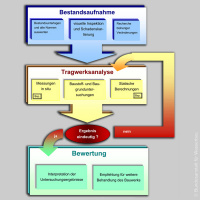Structural Engineering Methods: Difference between revisions
From BAWiki
No edit summary |
No edit summary |
||
| Line 1: | Line 1: | ||
[[de:Bautechnische Methoden]] | [[de:Bautechnische Methoden]] | ||
[[ | [[File:01_Bautechnische_Methoden_01.jpg|200px|thumb|right|Procedure of an expertise]] | ||
The Department of Structural Engineering makes use of numerical, testing and experimental methods. The purpose of these calculation methods is to provide the most realistic possible assessments of actions, structural elements or structures. Trials and laboratory analyses, partly based on test procedures developed by the BAW, help to make realistic assessments of actions, construction materials or the resistance of structural elements. Theoretical research work paves the way for experimental procedures. | The Department of Structural Engineering makes use of numerical, testing and experimental methods. The purpose of these calculation methods is to provide the most realistic possible assessments of actions, structural elements or structures. Trials and laboratory analyses, partly based on test procedures developed by the BAW, help to make realistic assessments of actions, construction materials or the resistance of structural elements. Theoretical research work paves the way for experimental procedures. | ||
Revision as of 07:37, 22 March 2022

The Department of Structural Engineering makes use of numerical, testing and experimental methods. The purpose of these calculation methods is to provide the most realistic possible assessments of actions, structural elements or structures. Trials and laboratory analyses, partly based on test procedures developed by the BAW, help to make realistic assessments of actions, construction materials or the resistance of structural elements. Theoretical research work paves the way for experimental procedures.
back to: Main Page
